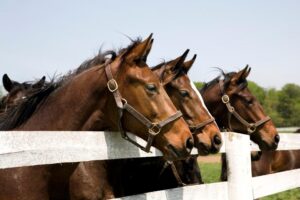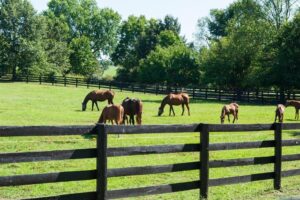The Thoroughbred
Thoroughbreds are a very versatile, highly intelligent breed that tend to adapt well to life after racing. Many Thoroughbreds have long and successful careers in other equestrian disciplines such as Showing, Eventing, Dressage, Polo and Showjumping, whilst many others happily take to life as a pleasure horse, spending their days trail riding into the sunset! In this article, we will share some tips for safely handling your Thoroughbred whilst they are adjusting to their new life after racing.
Tying up and Leading your Thoroughbred
Thoroughbreds in race preparation spend a lot of their time being tied up in cross ties, undercover, or in a fully enclosed stall or breezeway. Adjusting to being single tied out in the open can be very overwhelming. Some Thoroughbreds will dance around with their newly found space and in some cases will pull back. Introducing your horse slowly to being tied up in the open, with the assistance of a professional handler or with the aid of a pull-back collar can be beneficial and the safest option until they adjust to their new-found freedom.
Thoroughbreds in race work are very rarely led without a bit in their mouth. Either a rearing bit or off their bridle as most regulatory bodies insist on it for safety. Because of this, it is very likely that your Thoroughbred will have little to no respect for just a halter and may run through it or be very strong. Spending some time on groundwork and manners is an important part of their retraining to ensure a smooth and safe transition to their new life.
Everyday Handling
Introducing your Thoroughbred to their new environment can be highly overstimulating. There will potentially be many new and unfamiliar sights and sounds that they have not encountered during their racing days. Thoroughbreds are accustomed to being handled daily – including being rugged, hosed, ridden, and having the farrier and vet attending to them. They are exposed to the same sorts of external factors as most other breeds when they are young. Typically, they are bred, sent off to be prepared for racing, sent to a trainer where they are worked, trialled and raced. However, the environment that they are used to is, for the most part, controlled. They know no other way of life and so it’s important to gradually introduce them to their new environment, whilst controlling their exposure to stimuli wherever possible.
Floating
It is important to remember that most Thoroughbreds are only used to being trucked, so your horse may be a little apprehensive at first when loading them onto a horse float for the first time. Giving your Thoroughbred positive experiences is particularly important when introducing new things. If you are less experienced or are unsure, asking a more experienced friend or trainer for assistance may be the safest option.
Fencing
Fence visibility is of great importance when considering fencing for horses. They are prone to running into fences at considerable speed, resulting in damage to both the horse and the fence.
For this very reason most Thoroughbred breeding or spelling facilities host tall post and rail or horse rail fencing for the safety of the horses.
On agistment and private properties, post and rail or horse rail fencing is less common, purely due to the high-cost factor. We have provided some safety tips if you are introducing your thoroughbred into a paddock that is protected by wire or electric tape. Firstly, test that the electric fence is working, lead your horse around the boundary fence, and try to never turn them out into a new paddock on or close to dark.
If you are ever unsure or lack confidence with your off the track Thoroughbreds, there are many professionals that specialise in re-training, and education of Thoroughbreds, and it may be useful to engage one to guide you through the process. The journey of owning and working with an ‘off the track’ Thoroughbred, will at times be challenging, but also very rewarding!





